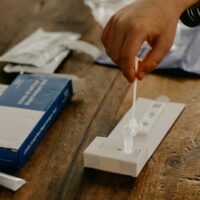Updated numbers from the federal government on Sunday show Jennie Stuart Medical Center under a more significant strain from the coronavirus pandemic than ever before.
From Jan. 1 to 7, an average of 31% of all adult inpatient beds at Jennie Stuart were occupied by people being treated for coronavirus. It’s the hospital’s highest ratio to-date and was the fifth-highest level statewide for the week.
According to research from the University of Washington’s Institute for Health Metrics and Evaluation, anything over 20% indicates a hospital is under “extreme stress.”
Since mid-November, Jennie Stuart’s average COVID-19 patient ratio has been at least 20% for six of the eight weeks. Before Jan. 1, the percentage had never exceeded 23%.
Last month, the U.S. Department of Health and Human Services began releasing hospital capacity numbers to provide a view of how the coronavirus pandemic is impacting hospitals and local communities across the country. Previously released data was aggregated at the state level.
“When data are aggregated at county or state level, the average across all facilities can mask what is happening at each local hospital,” the department said in a statement about the release. “Some hospitals might have additional capacity to treat COVID-19 patients, while others lack that capacity, for example. Using this new data, the public will have access to hospital-specific COVID-19 numbers to understand hyper-localized community impacts. This new level of transparency and increased access will accelerate COVID-19 insights and understanding.”
Hoptown Chronicle is reporting this data each time it’s released in an effort to help the community understand the pressure COVID-19 has placed on Hopkinsville’s only medical hospital.
What ‘capacity’ means and how it’s affected by COVID-19
Hospital capacity isn’t simply a static number, but an ever-changing combination of resources — including hospital beds, supplies and staff — and the overall severity of patient illness.
While it can’t paint the entire picture, health experts agree that a growing number of beds occupied by COVID-19 patients is an important indicator that can help predict strain on a health care system.
Patients being treated for coronavirus require significantly more staffing resources, in part, because of protocols surrounding personal protective equipment, which can present unique challenges for frontline health care workers.
Jennie Stuart ICU numbers signal concern
The Institute for Health Metrics and Evaluation’s framework says an ICU is under “extreme stress” if at least 60% of beds are occupied by patients being treated for coronavirus.
While Jennie Stuart’s ICU has exceeded this level before, it never coincided with the entire hospital also reaching the “extreme stress” level related to overall COVID-19 capacity — until Jan. 1.
During that week, the average coronavirus patient occupancy at the hospital’s ICU was 63%.
The total ICU occupancy, including non-COVID patients, was 73% — higher than any other time for which data is available. (Reports released by federal health officials date back to July 31.)
Daily patient totals suggest further strain
Since the most recent reporting period ended on Jan. 7, the average number of COVID-19 hospitalizations at Jennie Stuart has increased from 36 to 39 — suggesting the hospital could be dangerously full.
Jennie Stuart spokeswoman Selina Staub declined to release up-to-date details regarding the hospital’s capacity, specifically in the units where the sickest patients receive treatment — the intensive and progressive care units.
“Conveying ICU and PCU numbers would not provide an accurate perception since those number can fluctuate hourly and throughout the day,” Staub said. “The best information is the daily update regarding hospitalized COVID patients.”
In November, Beth McCraw, the hospital’s vice president of nursing and clinical services, provided an explanation to Hoptown Chronicle about how capacity in these units can evolve based on staffing levels, the severity of patient illness and nurse-to-patient ratios.
Typically, the hospital is staffed for about eight to 12 patients each in the ICU and PCU at any given time, she said. If demands increase in one area over the other, adjustments can be made, but the overall capacity between the two units would likely be somewhere around 20.
These numbers were also provided based on a two-to-one patient-to-nurse ratio. If a situation demands it, an ICU nurse might have three patients, but McCraw noted, “that’s not what we want,” because it’s such a heavy burden on nurses.
While the HHS release does not include information about the PCU, it does provide the seven-day average of occupied ICU beds. During the week of Jan. 1, that number at Jennie Stuart was 10.9 — more than any other week reported so far.
The next round of data for the week of Jan. 8 through 14 will be made public on Jan. 17.
Julia Hunter is the engagement editor for Hoptown Chronicle. Reach her at julia@hoptownchronicle.org.





